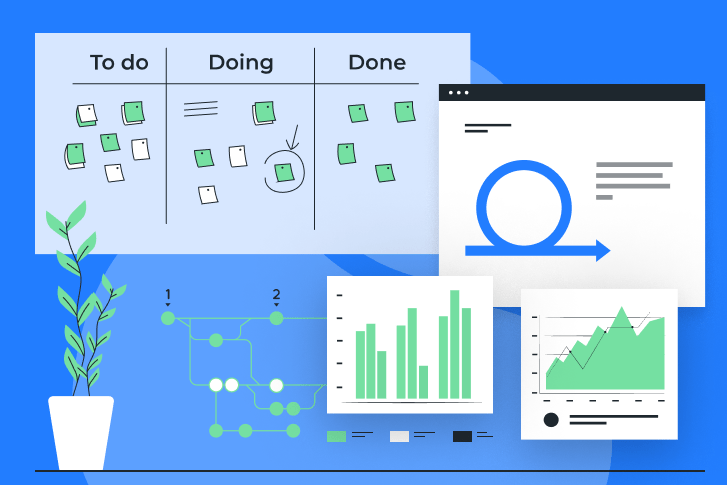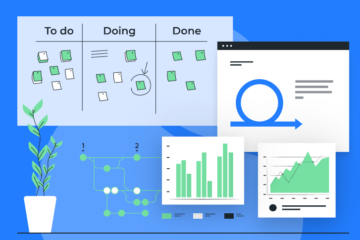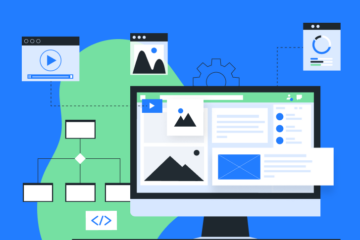Software Development Plan: Structure, Tools, Workflow

Guideline to Create, Refine, and Communicate Software Development Plan
From the moment the project idea is confirmed to the moment the finished product is delivered, there is a whole chain of events that determine how successful the final result will be: the volume, the budget, and the implementation timeline. However, the most critical factor of all is the people who bring the ideas to life. A well-considered software development plan requires a goal, clear objectives, a schedule, adaptations, and results. With such a plan in hand, the project manager can get an idea of costs and required resources. Defining these parameters in advance will make any progress all smoother. Doing so will prevent bottlenecks or points of failure from cropping up during the undertaking.
Additionally, a software development plan allows for a more simple software development process by describing it step-by-step and predicting all possible pitfalls, as well as guaranteeing the results. Let's go further into what such a plan has to offer and how to do software project planning.
What is a Software Development Plan?
A software development project plan sometimes called an SDP, describes the stepwise structure of all the processes required to bring a project to life, including aspects such as planning, idea generation, development, documentation, deployment, and sometimes maintenance. Mainly, a simple software development plan is needed to gather as much information as possible before starting the actual work in order to guarantee the highest level of control over the outcome. It describes the approach that will be used in software development and should be seen as a basic blueprint for guiding development efforts.
Various "Software Development Life Cycles" (SDLC) are widely used today, each of which offers its structure and approach to the challenges of moving from project start to project completion. Different techniques will be used depending on the requirements. Each of them offers a unique approach, so choosing the right one largely depends not only on the expected result but also on the parameters by which the software development plan outline will be executed.
One more question that should be answered in the very beginning is what is a software development project? A software development project is a complex activity carried out by two or more people within time, budget, and personnel constraints that create new or improved computer code and add considerable value to a current or new business process. The benefit of these projects is the potential to rapidly increase business value. These development projects will have significant business value, high visibility, medium to high difficulty, and urgency.
It’s critical to answer the question of what is planning in software engineering. Project planning in software engineering consists of tasks that are completed before the development process begins. Before embarking on software development, managers and business owners should strive to keep the situation under control, having previously created a software development strategy example, identified all key tasks, and also properly delegate such tasks among the team or teams. This is why planning is often considered so important because it is almost impossible to achieve good results without resorting to it, which in this case is effective software development.
Best Process Models in Software Engineering
To make your development process easier, we describe below the most popular software development process models.
Waterfall
The Waterfall Software Development Process (also known as the "Linear Sequential Model" or "Classic Life Cycle Model") is one of the oldest and most common models of the software improvement plan. In its simplest form, you can think of the waterfall method as executing each step of the software development lifecycle in sequence. Although, in most practical applications, the phases overlap slightly, with feedback and information being passed between them.
Agile
Agile software development plans opt for an iterative and agile development approach. Agile is all about moving fast, delivering frequent releases, and responding to the real needs of your users, even if it goes against your original plan. This means you don't need a complete list of requirements before getting started. Instead, you are moving in one direction, realizing that along the way, you will change course. Agile is widely considered the best process model in software engineering.
V-Shaped
The V-shaped software delivery plan takes on the classic waterfall method but makes up for its huge shortcoming: lack of testing. Rather than working step by step through the development process and saving all of your tests for later, each step of the V-shaped process is followed by a rigorous “validation and verification” phase where requirements are validated before moving on.
Software Development Planning Risks
When you approach each project with the seriousness it deserves, you must be careful at every stage of your plans. Having completed many software projects, our team at Hire Ukrainian Developers usually faces several hurdles. Navigating through these challenges has become routine in every project. Some of these obstacles are
Routh Estimates
It is necessary to make it clear to stakeholders that the estimated time and budget are approximate and may vary depending on certain factors and risks.
High Risks for Big Projects
The larger the scale of the project, the more likely it is that unexpected bottlenecks will occur in the software product development process, which can cause a number of delays.
Plans May Fulfill Wrong Needs
Software development projects are very dynamic and subject to constant change. Initially, this is because the specifics of the project have not been worked out in detail. So in the process, changes will need to be made. Teams and stakeholders change their minds in the light of new information. The software development plan should be flexible and tailored to the latest demands.
Plans Don’t Match Customers’ Desires
Most software is for human use. If you can't figure out what your target users want from the software, and the user experience is below average, no one will use it. Imagine wasting a considerable budget and long hours of development on something that people don't want to use.
Lack of Centralized Communication
A project may involve many people from your side, from the client's side, and others. Thus, a common problem in design and development processes is the lack of clear and centralized communication. It can lead to misunderstandings and misinterpretations of procedures and feedback. Here, management and reporting tools allow you to automate the entire communication process. While the documentation communicates your goals, software development processes, and procedures, frequent meetings give everyone the chance to be on the same page.
Software Development Project Management Tools
Many software development planning tools are widely used in projects of all shapes and sizes. This software helps project managers effectively organize and manage all of their tasks. The most popular among them are the following:
Trello
The focus of the app is on visual effects. This way the team has a clear layout of day-to-day project tasks in dashboards, which come in handy for tracking ideas from the earliest conception to the finished product. Trello allows you to:
- Create personalized Kanban boards hassle-free
- Manage tasks on “cardboards” in a simple way
- Share ideas visually with other team members
- Share files and images
- Create unlimited task lists
Price range: Free. There are also premium options for $9.99/year or $20.83/year.
Redmine
Redmine is an open-source project management tool that has been made very customizable by the community of volunteer developers. There are many plugins and themes available for it, with which your project can be radically customized. Teams features include:
- Convenient time tracking
- Cooperating on wikis and forums
- Gantt charts
- Kanban boards
- Email notifications
Price range: Free
Basecamp
This software solution ranks among the most widely used project management applications. Basecamp has a simple and user-friendly interface for collaboration between teammates and clients. The app is responsive, so you can enjoy all the features from any device on the go. With it, you can:
- Create to-do lists
- Have performance reports
- Manage and share files
- Setting up a discussion
- Date schedule
Price range: $99 per month for unlimited usage. Free subscriptions are available for teachers and students, 10% discount for nonprofits.
Jira
It is a cross-platform tracking solution well suited for Agile and Scrum projects. Jira allows you to:
- Creating custom stories
- Manage problems
- Allocation and prioritization of tasks
- Sprint planning
- Using customized Scrum and Kanban boards for iterations
Price range: $10/month for ten or fewer users, $75/month for fifteen users, $300/month for teams with fifty users.
Asana
Asana is one of the most solid and performative task management software for small teams. With its help, each team member knows who is doing what and when. Several features are:
- Create and keep track of different tasks, subtasks, projects, and sections
- Assign the task to specific individuals; create descriptions and timelines
- Provide instructions and comments on tasks
- Use notifications to always meet deadlines
- Engage in simple and effective communication (i.e. user likes, voting)
Price range: Free for the teams of up to 15 users, with the premium package running at $9.99 per month per member.
Best Practices for Creating a Software Development Plan
To be successful with your new software project plan, you need to follow standard best practices. They are highly workable – it won't take you long to incorporate them into your collaboration, but in the end, these details will make the difference.
The Workflow is Divided into Stages
Fulfilling the whole plan in one go is an impossible task. You will need to break the process down into manageable pieces. We suggest using a modular system: define each section as a module and assign responsible team members. Set a deadline for each stage and confirm that everyone is clear about the scope of their work.
Real-time Research Sharing
Research is a necessary process in software development. Market research results, user reviews, focus group interviews, and analysis of similar projects should be available to all team members in real-time. If there are updates, all participants should receive them at the same time.
The Plan is Continuously Updated
The software planning process is ongoing. Software development priorities are continuously developing. Software development needs to be up-to-date, so the participants need to come back to it regularly. Be sure to keep previous versions as well, in case any disagreements arise during the project. It’s possible to use color codes to manage various versions – take a look at the project plan example for software development.
The Users’ Interview Feedback
After the software is determined to be completed, the team should test it with real users. The results should be reflected in the software development plan. User interactions can inform developers on where to change focus or highlight new needs. All these changes should be noted in the plan.
How to Create a Software Development Plan
Now that you know why a plan is so critical, let's walk through how to plan a software development project. Here are a few general steps that most software projects go through. Consider them when developing your high-level development plan.
Research and Discovery
Before diving straight into a complicated project, take the time to get the full scope of work and specific requirements for a viable product. It’s necessary to talk to stakeholders, team members, and even future users to find out how the finished product should work to meet everyone's needs.
Design
While some teams may do design and development at the same time, the design team usually needs to visually bring an idea to life before they can start coding. Be sure to include time in your software design project plan for collecting feedback and getting the final approval of from stakeholders to ensure a smooth and timely delivery.
Setting up the Environment
A development environment is a set of processes and tools that are used to develop the source code of a program or software product. This includes the entire environment that supports the end-to-end process, including development, staging, and production servers.
Sprints Organization
A good IT development project plan covers every stage of the sprint, including:
- Sprint planning
- Sprint starting
- QA and testing
- Error debugging
- Stakeholder reviewing
- Deployment
There are no restrictions to the number of sprint cycles in your plan, so rinse and repeat the process for as many iterations as is needed. Just make sure you also schedule time for retrospective and backlog processing between sprint cycles.
Long-Term Plan for the Project
Add a backlog section to your system development project plan so you can change the functionality or account for new user input as the project progresses. Each software project is different, and the tasks you include in each stage of your plan will depend on the work you do. The software development plan template provides a great starting point and can be easily customized to suit your process and project needs.
The Structure of the Software Development Project Plan
It's important to think about everything from requirements to stakeholder engagement, development, and ongoing maintenance. These steps are pretty much the same for whatever software development process you use. However, as we will see later, the order and sequence in which they occur can change depending on your needs, goals, and the size of the project and team (for example, some steps can be combined, duplicated, or run in parallel). So, what are the steps in software development project planning?
Introduction
You have to have an understanding of the project planning objectives in software engineering which you are trying to achieve. This stage describes the purpose of the software development project and product. Your goal is to determine what type of development will take place, finalize the overall product concept, and the main expectations of the team.
- Project description: product concept, development goals
- The project needs: this section refers to business goals and tasks
- Abbreviations: You need to describe all abbreviations, special characters, and specific forms used in the document
Project Organization
This part is important for determining how the project will be structured, how communication between team members will work, and what the overall project flow will look like. In this stage, the team should determine all external groups involved – other teams and experts that the developers will interact with. Typically, the following groups are involved in a software development project:
Testing/QA
If testers do not initially collaborate with developers or are not actively involved in ideas and research, it is better to call them an external group rather than permanent contributors.
Deployment
The software development plan should detail who the operations teams are and their responsibilities. It should also describe the way coders interact in their respective areas of expertise.
Marketing
Marketing professionals should join a software development project in the early and late stages of development. The plan should have a designated marketing person who can be contacted by the developers at any time during the project.
The project organization ensures transparency to participants. Thus, each team member knows who is working on the project and understands the responsibility of each. If there is a bottleneck, you will have no problem finding out who is responsible.
Management
Most likely, the toughest point of a plan in the early stages of development is where you determine risk management, deadlines, budgeting, and more. The management section of the software development plan should be reviewed continuously throughout the project. Team estimates, resources, and results are likely to change, and software development plans should reflect these changes. However, it is imperative to keep the first version of the document unchanged so that stakeholders can always indicate the originally planned goals.
Project Control
To assure the successful implementation of the project, it is critical to determine material indicators in advance and constantly monitor the quality and efficiency of the work process and the results achieved. Here are some aspects that can help improve quality control:
- Tools used to control product compliance
- Tracking time and monetary expenditures
- Real-time access to code quality control reports
- A clear definition of what is considered a completed project
- Keeping management and stakeholders up to date on progress and methodology
Maintenance and Support
Due to the dynamism of software, the development life cycle doesn't end with deployment. . It progresses with the needs of the business. Thus, you should be prepared to add new features as they are called for. Moreover, all programs need periodic maintenance and optimization. You may need to maintain your software to keep it running smoothly.
Afterword
The planning process in software engineering is just as important as the development itself. It lays down the foundation for the success of your product and allows the team to educate stakeholders on their methodologies and standards. This is a long-term investment, and the software development plan will be a key document for years to come. What’s more, it’s possible to reuse approaches in other projects or products.
At Hire Ukrainian Developers, we take all software engineering development activities seriously. We aim to provide clients with objective project assessments, risk assessments, future customer collaboration, and realistic metrics for project success. Our business analysts and project managers will be more than happy to share their thoughts with you – just text us and briefly describe the scope of your project.





No comments